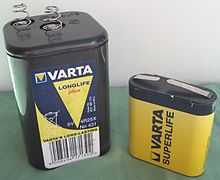Lantern battery

A lantern battery is a rectangular battery, typically an alkaline or zinc-carbon primary battery, used primarily in flashlights or lanterns. Lantern batteries are physically larger and consequently offer higher capacity than the more common torch batteries. Lantern batteries comprise multiple cells inside a housing.
The most common variant in the US is the 6 volt square-base battery with spring terminals. In Europe the most common is the 4.5 volt flat-pack types.[citation needed]
Common variants
6 Volt
The 6-volt variety typically has spring or screw terminals. Different types have different internal construction; the same package size may be made up with "D" size or "F" size cells, giving different capacity. A rechargeable version, comprising a three-cell sealed lead-acid battery with a lower capacity than primary versions, has also been marketed.[1]
A double-size version (same size as two normal versions next to each other) exists for applications requiring more capacity.
In the UK and Australia, it is used in the construction industry for powering flashing lights at roadworks. [2]
In Switzerland as of 2008, 6-volt lantern batteries accounted for 0.4% of primary battery sales. [3]
4.5 Volt
More common in Europe and Russian Federation, this is a smaller, flat-pack battery mostly used in flashlights. It uses two metal strips as terminals. The shorter strip is the + terminal.
This size of battery is sometimes found in disposable flashlights in the United States.
In Switzerland as of 2008, 4.5-volt lantern batteries accounted for 1% of primary battery sales. [4]
7.5 Volt
The 7.5-volt version has screw terminals and rectangular base. A carrying handle is usually connected between the terminals.
12 Volt
The 12-volt version has screw terminals and a rectangular base. Since it is 12-volt, this type can be used to power car accessories outside of an automobile, using extra wiring or an adapter.
Specifications and designations
| Name | IEC number | ANSI/NEDA | Manufacturer designations | Capacity (Ah) [5] | Dimensions (mm) |
|---|---|---|---|---|---|
| 4.5 Volt [6] | 3R12, 3LR12 | 3R12, 3LR12, 4.5v | G3LR12, 1289/AD28, 210, GP312S, MN1203, 3336 | 3 – 4.8 | 67 × 62 × 22 |
| 6 Volt, Spring fitting[7] | 4R25X, 4LR25X | 908AC, 908C, 908CD, 908D | EN1209, EN529, MN908, EV90, EV90HP, GP908, PJ996 | 12 – 26 | 115 × 68.2 × 68.2 |
| 6 volt, Screw fitting[8] | 4R25Y, 4LR25Y | 915A | EN528 | 26 | 109.5 × 66.7 × 66.7 |
| 6 Volt, double[9] | 4R25-2, 4LR25-2 | 918A | EN521, MN918, GP918S, GP918G, 918/1231 | 52 | 125.4 × 132.5 × 73 |
| 7.5 Volt[10] | 5LR25-2 | 903AC | EN715, PC903 | 43 | 97 × 184.2 × 103.2 |
| 12 Volt[11] | 8R25 | 926 | EN732, PC926 | 7.5 | 125.4 × 136.5 × 73 |
References
- ↑ CamdenBoss. "Rechargeable lantern battery". Retrieved 2012-10-08.
- ↑ "Flashing Warning Light". Retrieved 2011-06-04.
- ↑ INOBAT 2008 statistics.
- ↑ INOBAT 2008 statistics.
- ↑ When more than one figure is listed, the lower number refers to zinc-carbon batteries, the higher to alkaline.
- ↑ Golden Power Corporation (HK) LTD. "G3LR12 Engineering Data". Retrieved 2010-01-15.
- ↑ Eveready Battery Company. "EVR-1209 Engineering Data". Retrieved 2010-01-15.
- ↑ Eveready Battery Company. "EVR-528 Engineering Data". Retrieved 2010-01-15.
- ↑ Eveready Battery Company. "EVR-521 Engineering Data". Retrieved 2010-01-15.
- ↑ Eveready Battery Company. "EVR-715 Engineering Data". Retrieved 2010-01-15.
- ↑ Eveready Battery Company. "EVR-732 Engineering Data". Retrieved 2010-01-15.
| |||||||||||